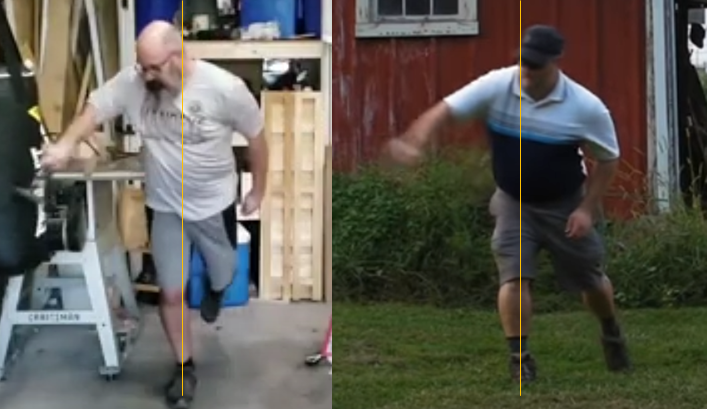- Joined
- Nov 2, 2008
- Messages
- 22,041
You want your shoulders/torso to turn back with the arm/disc more unfolding in place.
Discover new ways to elevate your game with the updated DGCourseReview app!
It's entirely free and enhanced with features shaped by user feedback to ensure your best experience on the course. (App Store or Google Play)
Do you have something you can safely hit with the hammer or slash into with a wrench or blade on one leg like I did into my heavy bag in the hammer vid? Film that and we can probably get that sorted more quickly. If your body always knows where you're trying to get it to go, it helps you work backwards from there. It matters more to swing safely and in control: give it no more than 80% for a few swings. Better to fix it first so you don't hurt yourself.
I can ramble more but you get the idea lol
Not sure if the prior advice was to stop doing one steps, or to stop doing one leg throws. It's an important difference but you or SW22 could advise. Unless you already got direct feedback on your one leg (not one step) hammer or other tool swing at a target, that's what I meant to triage.
Recommend we try a way to give your body clear strike or slash feedback safely. I agree with RowingBoats that once you trip the switch it makes a huge learning difference. Some people get it with hammer or tool throws, others with strikes.
Any pain/discomfort/feeling bunched anywhere when you swing like that? Would guess maybe shoulder and elbow.
Try stepping back away relative to the camera a little bit, and stepping maybe 6" further away relative to the bag. Keep staying nice and loose as you swing back and forward. You might find that you need to aim maybe 6-12" lower on the bag to hit it with decent impact- that's ok.

1. If I am the camera, either move 3-6" to my right (your left), or 3-6" away from me. Might be a combination of the two.
2. I think you're standing slightly too tall. Maybe get into a slightly deeper stance on the front leg - butt back just a bit more. You really want to feel like you can drop your weight into the leg and pump the ground with it to lead the swing.
3. Might as well try to keep that rear arm closer to the rear hip. Rear leg counterbalance looks ok for now.
Here is what I did, but I don't think that is what you wanted.
I'm not sure this is the right idea. One of the things my PT buddy noticed about Rathbun's swing is that the rear hand is actually pushing away from the hip as it comes forward. I notice this is very different than a bunch of other players who get the hand and forearm very tight. He is thinking that's part of the key to getting torso rotation while maintaining lead arm angle given my shoulder mobility.
Going to hurt your shoulder hitting with it open. Keep your shoulders closed to target and hammer it or punch it. You should feel your lat engaged like holding extension at the top of a bench press/push up, pressing against/thru the bag or floor or wall or disc.
https://www.youtube.com/watch?v=ZlyD1ynQrh4#t=3m26s
Might be talking past each other. Notice how close Rathbun's rear elbow is to his rear hip or torso. From the first to second frame, his lower arm is still swimming through and counterrotating the swing just like every other top thrower. So you might find his posture more ergonomic but the action is the same.
I'm not sure if you are saying all of the examples are open or not.
Am I right in thinking that the position I am in on the far left is closed and the one on the far right is open? And that the one on the right is what you are saying needs to be avoided?
Is the one on the left closed enough? And the one in the middle is still too open?

Going to hurt your shoulder hitting with it open. Keep your shoulders closed to target and hammer it or punch it. You should feel your lat engaged like holding extension at the top of a bench press/push up, pressing against/thru the bag or floor or wall or disc.
I'm not sure if you are saying all of the examples are open or not.
Am I right in thinking that the position I am in on the far left is closed and the one on the far right is open? And that the one on the right is what you are saying needs to be avoided?
Is the one on the left closed enough? And the one in the middle is still too open?
I'm looking at the action pattern rather than stillframes. It looks like your elbow is rolling down toward the floor early, leading to a slightly open shoulder - "closed" here means that it is still internally rotated going into the strike, and it starts externally rotating in the follow through (if you could actually smash all the way